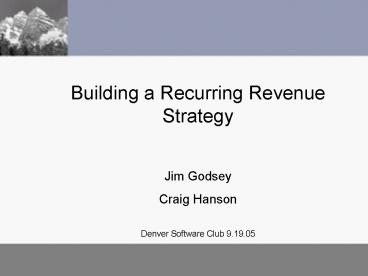Building a Recurring Revenue Strategy PowerPoint PPT Presentation
1 / 18
Title: Building a Recurring Revenue Strategy
1
Building a Recurring Revenue Strategy Jim
Godsey Craig Hanson Denver Software Club 9.19.05
2
Agenda
- Industry Trends
- Definitions
- Subscription vs. Perpetual Licensing
- Setting Prices
- Launching Subscription Licensing
- The Investor Acquirers Perspective
- Impact on Valuation
3
Movement toward subscription-based software
- We define On Demand as . . Term based
licensing and outsourced delivery . . We expect
more customers to opt for term or subscription
based licensing versus the traditional perpetual
model and move toward outsourced solutions. Very
simply put, software in an On Demand world will
change the way customers buy, vendors sell, and
investors invest. - Merrill Lynch
- It is clear that the traditional software
business model is unwinding . . On demand is
becoming the preferred method for licensing and
deploying software. The impact on valuations and
creating sustainable shareholder wealth are
enormous. - Credit Suisse First Boston
- By 2008, over 50 of software purchases will be
via Software-as-a-Service - Gartner
4
Movement toward subscription-based software
- 33 of ISVs already offer subscription-based
pricing. Within next 2 years, 52 expect to
offer subscription-based pricing as their primary
sales model - Source SIIA, Key Trends in Software Pricing and
Licensing - Figure was 21 just a year ago, according to
VARBusiness 2005 State of Software - Greater initial adoption by small and mid-size
customers - Most successful technology attacks start at the
low end Clayton Christensen idea
5
Definitions
- Licensing
- Perpetual
- Subscription
- Utility
- Pricing
- Site
- Per Unit
- Value
- Deployment
- In-house
- Hosted
Pick one from each
6
Subscription vs. perpetual
- Perpetual
- No license term
- Larger transaction amounts up front
- Choppy quarter on quarter revenue behavior
- Separate maintenance revenue stream
- Subscription
- Limited license term
- Lower short term revenue, but higher long term
revenue - Improved revenue visibility consistency
- Slower revenue growth
- Shorter ROI time scale
- Requires adjustments to reseller networks
7
What is your value add?
8
What is your value add?
9
What is your value add worth?
10
Calculating subscription price
11
Launching subscription pricing
- Determine value
- Prepare revenue accounting procedures
- Prepare contracts
- Prepare contract administration and billing
systems - Establish term set price
12
Why do investors and acquirers like recurring
revenue models?
- Predictable, compounding revenue stream
- Less volatility, better ability to plan
- No end-of-quarter frenzied pricing discounts
better margin potential - Shorter commitment period hastens customer
adoption - Chance for new entrants to steal market share
from publicly-traded competitors, which have a
harder time taking the one-time hit for the
switch to subscriptions
13
. . . The downside
- Slower revenue growth
- Slower cash inflow
- Therefore, more cash required to fund company to
breakeven
14
Recurring revenue is more highly valued by the
market
- Wall Street and private investors attach a
premium multiple to recurring - preferably
contractual - revenue - More debt financing ability
- Lenders willing to provide more debt with safer
cash inflow, and will sometimes lend off this
rather than AR or tangible assets - VCs increasingly favor this model
- Jamcracker estimates that 90 of new software
companies funded by VCs have SaaS models - Acquisitions of recurring revenue companies are
heating up
15
Valuation impact comparable metrics
- Is subscription pricing a net positive or net
negative in your companys valuation? Two ways
to compare. - 1 Can use different valuation metrics.
- Under subscription model, revenue is booked upon
signing the contract, but recognized ratably over
the subscription term. - These future revenues show up on balance sheet as
deferred revenue. - Over time, deferred subscription revenue is
transferred to the income statement. - Therefore, a better metric is Bookings Growth
- Bookings Growth reported revenue changes in
deferred revenue - Over time, cash flow growth rate becomes good
indicator
16
Valuation impact recurring revenue premium
- 2 Valuation premium attached to recurring
revenue companies but does it justify the
switch? - Hard to isolate the valuation differential
- Rough calculation shows average public software
company trading at 3.4x 2005 revenue - Small sample universe of recurring revenue
software companies trade at 4.9x 2005 revenue
(40 premium) - Similar Price-to-Free Cash Flow multiple premium
of 36 (19x vs. 26x) - For early stage companies, how much of a premium?
- With these multiples, valuation can take a net
hit in the early stages of a company, but will
attain a net premium as revenue grows and
compounds
17
Considerations for early stage companies
- For early stage companies, how much of a premium
do they get from VCs? - Factors to consider
- Not as simple as 3x product pricing translating
into valuation premium, because, increasingly,
revenue under subscription model bolstered by
past bookings - Perpetual model gives you (most of) the cash
upfront, and results in quicker cash flow
breakeven, and less capital needed - VCs also look at prospective valuation of the
next round, so the calculation depends on how
soon the companys deferred revenue valuation
premium can catch up to a perpetual model - Another important factor is renewal rates /
expected life of subscriber without longevity,
model doesnt work - Calculation ultimately dependant on the companys
particular business model - Bottom line Think of what is best for your
company in the long-term revenue, competitive
advantage, exit valuation - not just the
valuation youll receive from your first venture
round.
18
Thank you
- Jim Godsey
- jdgodsey1_at_comcast.net
- Craig Hanson
- Vista Ventures
- craig_at_vistavc.com

